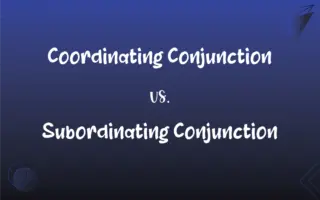Reversion Mutation vs. Suppression Mutation: What's the Difference?
Edited by Aimie Carlson || By Janet White || Published on March 7, 2024
Reversion mutation restores the original phenotype by reversing a prior mutation, while suppression mutation introduces a new change that compensates for the effects of an existing mutation without reversing the original mutation.

Key Differences
Reversion mutations are genetic changes that restore the original DNA sequence or phenotype that was altered by a previous mutation, effectively "reversing" the effects of the initial mutation. In contrast, suppression mutations do not reverse the original mutation at the DNA sequence level but instead introduce a second mutation that compensates for or suppresses the phenotypic effects of the first mutation, often occurring in a different gene.
Reversion mutations can occur through precise correction of the original mutation or through a secondary mutation that restores function or phenotype, not necessarily reverting the exact DNA sequence. Suppression mutations, however, may work through various mechanisms, such as altering the translation process, modifying protein function, or through changes in regulatory sequences, to mitigate the effects of the original mutation.
Reversion mutations can lead to a complete restoration of the original phenotype, suppression mutations may only partially restore function or lead to a new, viable phenotype that differs from the original.
Comparison Chart
Definition
Mutation that reverses a previous mutation's effect on the phenotype or DNA sequence.
Mutation that compensates for the effects of another mutation without reversing the original DNA change.
Mechanism
Restores original DNA sequence or function directly.
Introduces a new genetic change that alleviates the phenotypic effect of the original mutation.
ADVERTISEMENT
Outcome on Phenotype
Often fully restores the original phenotype.
May partially restore function or result in a new, viable phenotype.
Location Relative to Original Mutation
Typically occurs at the same site as the original mutation.
Often occurs at a different genetic locus than the original mutation.
Effect on DNA Sequence
May restore the original sequence or achieve functional restoration through compensatory changes.
Does not alter the original mutated sequence but adds a new mutation elsewhere.
Reversion Mutation and Suppression Mutation Definitions
Reversion Mutation
Can occur through precise DNA sequence correction or compensatory changes.
The yeast's enzyme activity was restored by a reversion mutation in the regulatory region.
Suppression Mutation
Often requires a precise genetic context or environment to be effective.
In a specific genetic background, a suppression mutation enabled the plants to overcome the growth defect caused by the original mutation.
ADVERTISEMENT
Reversion Mutation
A genetic change that reverses the effects of a previous mutation.
The bacterium regained its ability to synthesize amino acids due to a reversion mutation.
Suppression Mutation
A secondary mutation that compensates for the effects of a primary mutation.
A suppression mutation in a different gene restored the cell's ability to divide normally.
Reversion Mutation
Restores the original phenotype by correcting the initial genetic alteration.
A reversion mutation restored the fruit fly's wing size to normal.
Suppression Mutation
Can involve changes in protein function, regulatory elements, or gene expression.
A suppression mutation altered the transcription factor's binding affinity, compensating for the loss of a regulatory gene.
Reversion Mutation
Often results in the full restoration of original function or phenotype.
The reversion mutation allowed the plant to revert to its wild-type flower color.
Suppression Mutation
Works by introducing a new change that alleviates the phenotypic impact of an existing mutation.
The genetic disorder's severity was reduced by a naturally occurring suppression mutation.
Reversion Mutation
May occur spontaneously or be induced under certain conditions.
After exposure to a mild mutagen, a reversion mutation reversed the microbial resistance to antibiotics.
Suppression Mutation
May not restore the original phenotype but leads to a new, viable state.
Due to a suppression mutation, the mutated fish developed an alternative way to regulate its swim bladder function.
FAQs
What is a suppression mutation?
A suppression mutation is a secondary mutation that compensates for the effects of a primary mutation, leading to a restored or new viable phenotype without reversing the original DNA change.
How does a reversion mutation occur?
It can occur through direct correction of the original DNA sequence or through a compensatory mutation that restores the original function or phenotype.
What mechanisms do suppression mutations use?
Suppression mutations can work through various mechanisms, such as altering protein function, modifying regulatory sequences, or changing gene expression, to alleviate the effects of the original mutation.
What is a reversion mutation?
A reversion mutation is a genetic change that reverses the effect of a previous mutation, potentially restoring the original phenotype or DNA sequence.
Can suppression mutations occur at the same site as the original mutation?
Suppression mutations usually occur at a different genetic locus than the original mutation, often in a gene that interacts with or is related to the gene containing the original mutation.
What is the outcome of a suppression mutation on the phenotype?
The outcome can range from partial restoration of function to the development of a new, viable phenotype that compensates for the original mutation's effects.
Do reversion mutations alter the original mutated DNA sequence?
Reversion mutations can either directly reverse the original mutated sequence or achieve functional restoration without precisely reverting the DNA sequence.
Can reversion mutations fully restore the original phenotype?
Yes, reversion mutations can fully restore the original phenotype, especially if the DNA sequence is precisely corrected.
Can both reversion and suppression mutations be beneficial?
Both types of mutations can be beneficial, depending on the context, by restoring lost functions or providing new functional adaptations.
Are suppression mutations always effective?
Suppression mutations may not always be effective, as their success can depend on the specific genetic context and the nature of the original mutation.
How do suppression mutations contribute to genetic diversity?
Suppression mutations contribute to genetic diversity by introducing new genetic variations that can lead to novel phenotypes and adaptive advantages.
Are there any risks associated with reversion mutations?
While reversion mutations can restore function, they might also reintroduce vulnerabilities or negative traits that were eliminated by the original mutation.
Where do reversion mutations typically occur?
They typically occur at the same site or within the same gene as the original mutation, either precisely reversing the DNA change or through a nearby compensatory mutation.
How do suppression mutations differ from reversion mutations in terms of DNA sequence?
Suppression mutations add a new mutation without altering the original mutated sequence, while reversion mutations can involve changes to the original sequence.
What are the implications of suppression mutations for genetic diseases?
Suppression mutations can offer insights into potential therapeutic strategies by identifying pathways and mechanisms that can compensate for disease-causing mutations.
Can suppression mutations lead to entirely new genetic traits?
Yes, suppression mutations have the potential to lead to new traits or functions that were not present before the original mutation, contributing to evolutionary processes.
Can environmental factors influence reversion mutations?
Yes, environmental factors such as exposure to mutagens can influence the rate and occurrence of reversion mutations.
Are suppression mutations specific to certain types of genes or functions?
Suppression mutations can occur in various genes but are often most effective in genes that have functional relationships or interactions with the gene containing the original mutation.
Can reversion mutations be induced in a laboratory setting?
Yes, reversion mutations can be induced through experimental conditions, often used in genetic studies to understand gene function and mutation effects.
Is it possible to predict the occurrence of reversion mutations?
Predicting the exact occurrence of reversion mutations is challenging due to the random nature of mutations, but certain mutational hotspots may have higher chances.
About Author
Written by
Janet WhiteJanet White has been an esteemed writer and blogger for Difference Wiki. Holding a Master's degree in Science and Medical Journalism from the prestigious Boston University, she has consistently demonstrated her expertise and passion for her field. When she's not immersed in her work, Janet relishes her time exercising, delving into a good book, and cherishing moments with friends and family.
Edited by
Aimie CarlsonAimie Carlson, holding a master's degree in English literature, is a fervent English language enthusiast. She lends her writing talents to Difference Wiki, a prominent website that specializes in comparisons, offering readers insightful analyses that both captivate and inform.































































